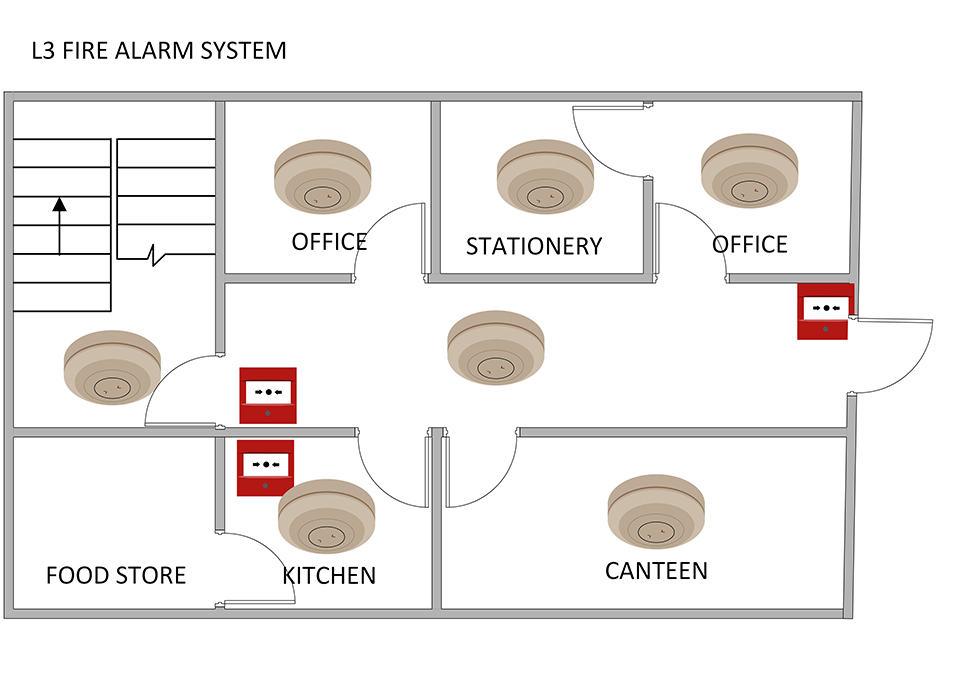Fire Detection and Alarm System Categories Explained – 16 July 2021
Fire Detection and Alarm System Categories Explained (non-domestic premises)
There are eight categories of Fire Detection and Alarm Systems as defined in the British Standard 5839 Part 1 Fire detection and fire alarm systems for buildings. Code of practice for design, installation, commissioning, and maintenance of systems in non-domestic premises. Each category falls under three different type of system.
M – Manual system, no automatic fire detectors so the building is fitted with call points and sounders
L – Automatic Systems intended for the protection of life.
P – Automatic Systems intended for the protection of property.
A fire risk assessment should be carried out to establish which alarm type and category is required for your premises.
Category M – Manual fire alarm system
Category L1 – Maximum life protection automated fire detection and alarm system
Category L2 – Additional life protection automated fire detection and alarm system
Category L3 – Standard life protection automated fire detection and alarm system
Category L4 – Modest life protection automated fire detection and alarm system
Category L5 – Localised life protection automated fire detection and alarm system
Category P1 – Maximum property protection automated fire detection and alarm system
Category P2 – Minimum property protection automated fire detection and alarm system
Category M – Manual fire alarm system
Category M fire alarm systems are common for places of work, such as offices, shops, factories, warehouses and restaurants. Fire alarm systems in this category are manual, where the alarm must be activated by a person using a Manual Call Point. Typical adoption of this category are offices, shops, factories, warehouses and restaurants. A Category M system normally satisfies the requirements of legislation. It is, however, often combined with a Category P system to satisfy the requirements of insurers, as company policy for protection of assets, or to protect against business interruption.

Category L1 – Maximum life protection automated fire detection and alarm system
Category L1 fire detection and alarm systems provide the maximum level of life protection and are often provided in large or complex buildings such as stadiums, hospitals, care homes, shopping centres, large mixed use office blocks as well as sleeping accommodation such as hotels, hostels, student accommodation, houses under multiple occupation. Automatic fire detection is installed in all rooms and areas of the building including roof spaces and voids.

Category L2 – Additional life protection automated fire detection and alarm system
Category L2 fire detection and alarm systems are designed to give an early warning of fire to occupants beyond the room in which the fire originates and provide early detection in areas of high risk. Example areas of high risk include boiler rooms, plant rooms, computer/server rooms and other areas with heavy plant machinery. Typical adoption of this category are factories and medium sized sleeping accommodation residential properties.

Category L3 – Standard life protection automated fire detection and alarm system
Category L3 fire detection and alarm systems provide warning to occupants beyond the room in which the fire originates, enabling occupants to use the escape routes such as corridors and staircases before they become filled with smoke. Automatic fire detection should be installed on all escape routes and in all rooms that open onto an escape route. Typical adoption of this category are medium sized office blocks and commercial buildings with stairs.

Category L4 – Modest life protection automated fire detection and alarm system
Category L4 fire detection and alarm systems provide automatic fire detection within escape routes comprising circulation areas and spaces, such as corridors and stairways. An L4 system would not satisfy the requirements of legislation in buildings in which people sleep. Typical adoption of this category are commercial premises.

Category L5 – Localised life protection automated fire detection and alarm system
A category L5 fire detection and alarm system is designed specifically from the recommendations of a fire risk assessment. This custom category needs to be specified by a qualified fire engineer usually include automatic fire detection which is installed to meet the occupiers use of the premises.

Category P1 – Maximum property protection automated fire detection and alarm system A category P1 fire detection and alarm system protects buildings that are critical to the operation of a business. Maximum protection is provided to the whole site such as having automatic fire detection in all areas of the building, enabling the prompt detection and neutralisation of a potential fire as quickly as possible.

Category P2 – Minimum property protection automated fire detection and alarm system A category P2 fire detection and alarm system protects high risk areas of a building and provides early detection from the most likely sources of a fire and helps to minimize the damage to a property and business.

RES are accredited to British Standard Institute BSI EN ISO 9000, are a BSI Kitemark Licenced Fire Alarm Installer, and have BAFE Accreditation for Fire Detection and Alarm System Modular Scheme SP203 – Part 1. RES are also members of The British Fire Consortium, Fire Industry Association, The Fire Protection Association.
;)
